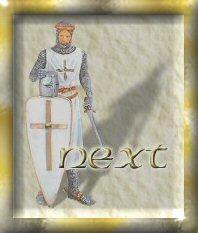|  FIRST CRUSADE MAJOR PLAYERS | Pope Urban II | Issued call for crusade on November 27, 1095 in Clermont, France | | Alexius I Commenus | Emperor of Byzantium, appealed for help to Robert of Flanders for protection from the Turks who were threatening the borders of his Christian empire | | Bishop Adehmar of LePuy | Started the wearing of the red cross that became a fashion statement with Crusaders | | Peter the Hermit | A commoner so moved by the ideals of the Crusade that he started a People's Crusade, a march of common folk who were the first army to approach the Eastern Empire borders | | Walter Sans-Avoir | Military leader of the People's Crusade | | Raymond IV of St Gilles, Count of Toulouse | Crusader General, Southern France | | Bohemond, Duke of Taranto | Crisader General, Southern Italy | | Godfrey of Bouillon | Crusader General, Northern France | | Hugh, Count of Vermandois | Crusader General, Northern France | | Robert, Duke of Normandy | Crusader General, Northern France | | Kilij Arslan | Sultan of the Turkish state of Rhum, protector of Nicea | | Kerbhoga, Attaman of Mosul | Leader of a Turkish Army sent to save the city of Antioch | | Firouz | Armenian guard at the city of Antioch, who let the Crusaders in | MAJOR BATTLES | Xerigordon | A Turkish fortress that was captured by Rainald's contingent of the People's Crusade, & recaptured by the Turks 8 days later | | Nicea Valley | The site at which the Turks trapped Burel's contingent of the People's Crusade & wiped out the entire army | | Nicea | The main crusading army laid siege to this city, which eventually surrendered to the Emporer, thwarting the Crusaders' plans to sack it for its riches | | Dorylaeum | Sitw where Bohemond's forces were ambushed by Sultan Arslan; Bohemond was rescued when the other half of the Crusader Army met his forces here | | Edessa | Captured by Baldwin | | Antioch | Captured by Crusaders when Bohemond gained entrance via an Antoich traitor, who let him in at the gate | | Jerusalem | Captured by the Crusaders in 1099 | The call that prompted the first Crusades came from Emperor Alexius of Byzantium. He sent an urgent plea to Robert, Duke of Normandy for help in protecting his Empire from the Turks, who had captured lands leading all the way to the doorstep of his capital city. When Pope Urban heard about the plea for help sent by Emperor Alexius, he was motivated by two chief reasons to reach out and help his neighbor. Firstly the Byzantine capital was considered one of the holiest sites in Christendom, mainly because of its preponderance of holy relics. Pope Urban was also attracted by the enormous wealth of the Empire's treasury, which was promised to those who could defeat the Turks. Peter the Hermit began his march towards Byzantium before the Western Empire could even begin to rally its trained troops. His group of commoners, most of who were attracted to join the fastly growing group of followers who clung to Peter, was known as the People's Crusade. This group was poorly led and soon split in two, one half wandering off with a military leader named Walter Sans-Avoir. Peter's group was almost uncontrollable. While staying in Semlin they massacred 4,000 Hungarians. Walter found little welcome in Bulgaria, and in Belgrade his army reacted by ransacking the countryside when they were forbidden entrance into the city. The locals fought back and killed 150 Crusaders. The People's Crusade was perhaps best well known for stopping off in Mainz and savagely massacring over 1000 Jews. When Peter's contingent reached Belgrade, they burned the city to the ground. While approaching Nish, the Crusading army once again became hostile and began sacking the countryside. This time a Byzantine army garrison rode out to meet them, and the fighting lasted for 3 days. When it concluded, 10,000 Crusaders had been killed. The Emperor Alexius sent a contingent of soldiers out to meet the remaining Crusaders, to insure that they finished the trip to Byzantium without further incident. All of this slaughter occurred before the People's Crusade actually reached Turkish lands. The People's Crusade set off in March of 1096 and reached Byzantium in August. The official Crusading army did not set off for Byzantium until the middle of the year. Emperor Alexius advised Peter to wait until the main army arrived before crossing the Bosphorus harbor, and into Turkish territory. But the People's army had split along national lines, with the Germans and Italians following Rainald and the Franks following Geoffrey Burel. Both men headed across the Bosphorus taking the People's Crusaders with them, while Peter elected to stay in Byzantium. The People's Crusade kept up their typical indiscretion, attacking villages that were under Turkish control, but populated with Christian citizens. Rainald's forces successfully captured the fortress Xerigordon, but were then surrounded by the Turks and were forced to surrender. Burel decided to attack Nicea, but the Turks were aware of his plans. They laid a trap and captured the Crusader army in a valley, slaughtering almost all of the Crusaders. Those who escaped were quickly found in the army's camp and were killed as well. Only a few thousand of the Crusaders made it back to the shores of the Bosphorus, and were rescued by Emperor Alexius. The official Crusading army set off from three different areas of the West. From Northern France, Robert, Hugh, and Godfrey led an army. From southern France, Raymond led another army, and from southern Italy Bohemond led another group. The armies arrived in Byzantium over the course of several months, early in 1097. After a long debate the various generals were convinced to swear allegiance to Emperor Alexius. Most of them were mainly concerned over which one would be named the head of the Crusading army. The army finally crossed the Bosphorus and laid siege to the fortress at Nicea. The region's Sultan, Arslan, was away fighting another local group. Negotiations were made by the city of Nicea behind the Crusader's backs and the city finally surrendered to Alexius. The Crusaders were shocked to see the Emperor's flag flown over the city one day, and infuriated that the Emperor declared that the city was not to be sacked.
The army next moved on to Antioch, and in the process split into two groups. Bohemond's contingent was surprised by a Turkish army led by the Sultan Arslan, and was only rescued when the other half of the army, led by Raymond and Bishop Adhemar, appeared in the distance, causing the Turks to scatter. Baldwin was able to successfully split from the main Crusading army with a contingent of men, and captured the city of Edessa. In October of 1097 the Crusading armies camped outside of Antioch and set up a blockade. They found it impossible to attack and breach the city's defenses. The army ran short of food and many died. Bishop Adhemar was among them. The Crusaders were becoming desperate, having heard that Kerbogha was bringing a Turkish army to save the city of Antioch. Fortunately Bohemond had befriended an Armenian man named Firouz within the city walls who was willing to help the army gain entrance to Antioch. Having successfully captured Antioch by sneaking in at night, the Crusaders themselves were now trapped in the city as the army of Kerbogha set up its own blockade. Alexius had sent troops to relieve the Crusaders, but he heard from Stephen of Blois how desperate the situation had become at the Crusader camp and decided to return to Byzantium. He did not receive word that the city had been taken. Morale was quickly slipping in the Crusader ranks when a pheasant named Peter Bartholomew declared that he had found the spear that pierced Christ's side hidden under the altar at the Church of St. Peter. Though the Crusader generals questioned the miraculous discovery of this spear, they decided to use the spear as a sign of God's divine support of the Crusader cause. Kerbogha's troops were equally demoralized by the long siege outside of Antioch, and they allowed the Crusader army to form up outside the walls of Antioch for one last deciding battle. The Crusaders, believing themselves under the protection of God, were victorious. The City of Antioch was now under the complete control of the Crusaders. Now the old battle arouses among the leaders of the Crusade- who was the leader of the group and who would be granted possession of the city. Bohemond finally won the vote, and the remainder of the Crusader armies under Raymond of St. Gilles set out to capture Jerusalem, leaving Bohemond and a few troops to secure Antioch and the surrounding countryside. The journey to Jerusalem was fairly uneventful. The Crusader armies set up camp outside the city walls to prepare for another siege. This time they had the threat of an approaching Egyptian army and they began to construct siege machines to breach the city walls. Religious fervor among the Crusaders reached a new level, with Peter Desiderius claiming he received a vision from the deceased Bishop Adhemar. The Crusaders paraded barefoot around the walls of Jerusalem carrying their holy relics before them. Six days later the final attack on the city began, and Godfrey and Robert managed to gain entrance to Jerusalem through a weak part in the wall defenses. The Crusaders went on a rampage through the city of Jerusalem. Many accounts tell of how the streets ran red with rivers of blood. Those who sought shelter in the Dome of the Rock were massacred. Most of the Jews sought shelter in the main synagogue, which the Crusaders barred and burnt to the ground. Iftikhar ad-Daula, the governor of Jerusalem, sought shelter in the Tower of David, and was eventually allowed to leave unharmed. And so ended the First Crusade in 1099. Certainly the most successful of the Crusades, and the farthest into Turkish territory that the Crusaders would ever be able to go. 
page design & graphix© ForeverAmber series content 2002©Sand Pypur |
 Free Forum Hosting
Free Forum Hosting